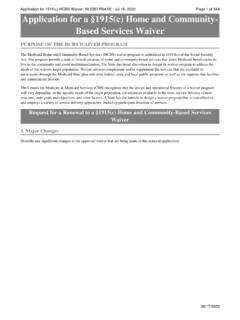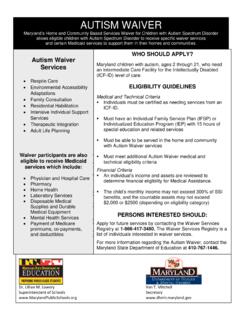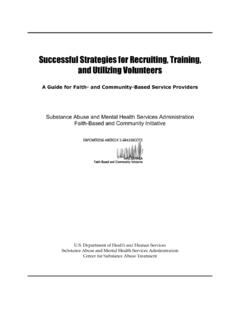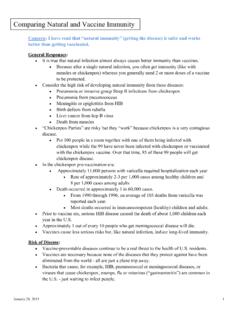Transcription of 1135 Waiver at a Glance - Centers for Medicare & Medicaid ...
1 1135 Waiver - At A Glance 1135 Waiver When the President declares a disaster or emergency under the Stafford Act or National Emergencies Act and the HHS Secretary declares a public health emergency under Section 319 of the Public Health Service Act, the Secretary is authorized to take certain actions in addition to his/her regular authorities. For example, under section 1135 of the Social Security Act, the Secretary may temporarily waive or modify certain Medicare , Medicaid , and Children s Health Insurance Program (CHIP) requirements to ensure: 1. Sufficient health care items and services are available to meet the needs of individuals enrolled in Social Security Act programs in the emergency area and time periods 2.
2 Providers who give such services in good faith can be reimbursed and exempted from sanctions (absent any determination of fraud or abuse). Examples of these 1135 waivers or modifications include: Conditions of participation or other certification requirements Program participation and similar requirements Preapproval requirements Requirements that physicians and other health care professionals be licensed in the State in which they are providing services, so long as they have equivalent licensing in another State. (This Waiver is for purposes of Medicare , Medicaid , and CHIP reimbursement only state law governs whether a non-Federal provider is authorized to provide services in the state without state licensure) Emergency Medical Treatment and Labor Act (EMTALA) sanctions for redirection of an individual to receive a medical screening examination in an alternative location pursuant to a state emergency preparedness plan (or in the case of a public health emergency involving pandemic infectious disease, a state pandemic preparedness plan)
3 Or transfer of an individual who has not been stabilized if the transfer is necessitated by the circumstances of the declared emergency. A Waiver of EMTALA requirements is effective only if actions under the Waiver do not discriminate on the basis of a patient s source of payment or ability to pay. Stark self-referral sanctions Performance deadlines and timetables may be adjusted (but not waived). Limitations on payment to permit Medicare enrollees to use out of network providers in an emergency situation These waivers under section 1135 of the Social Security Act typically end no later than the termination of the emergency period, or 60 days from the date the Waiver or modification is first published unless the Secretary of HHS extends the Waiver by notice for additional periods of up to 60 days, up to the end of the emergency period.
4 Waivers for EMTALA (for public health emergencies that do not involve a pandemic disease) and HIPAA requirements are limited to a 72-hour period beginning upon implementation of a hospital disaster protocol. Waiver of EMTALA requirements for emergencies that involve a pandemic disease last until termination of the pandemic-related public health emergency. The 1135 Waiver authority applies only to Federal requirements and does not apply to State requirements for licensure or conditions of participation. In addition to the 1135 Waiver authority, Section 1812(f) of the Social Security Act (the Act) authorizes the Secretary to provide for SNF coverage in the absence of a qualifying hospital stay, as long as this action does not increase overall program payments and does not alter the SNF benefit s acute care nature (that is, its orientation toward relatively short-term and intensive care).
5 Under this authority, CMS can issue a temporary Waiver of the SNF benefit s qualifying hospital stay requirement for those beneficiaries who are evacuated or transferred as a result of the emergency situation. In this way, beneficiaries who may have been discharged from a hospital early to make room for more seriously ill patients will be eligible for Medicare Part A SNF benefits. In addition, beneficiaries who had not been in a hospital or SNF prior to being evacuated, but who need skilled nursing care as a result of the emergency, will be eligible for Medicare Part A SNF coverage without having to meet the 3-day qualifying hospital stay requirement.
6 Trigger Points (Determining if Waivers Are Necessary) In determining whether to invoke an 1135 Waiver (once the conditions precedent to the authority s exercise have been met), the Assistant Secretary for Preparedness and Response (ASPR) convenes a meeting of relevant OPDIVS to determine the need and scope for such modifications. Information considered includes requests from Governors offices, feedback from individual healthcare providers and associations, requests to regional or field offices for assistance, and information obtained from the Secretary s Operation Center. The intent is to determine whether the waivers or modifications allowed under the 1135 Waiver Authority will assist healthcare providers in dealing with the response to a disaster.
7 While hurricanes and other disasters represent a date-certain impact and generally known duration, public health emergencies around diseases or viruses may be considered a more diffuse and dispersed event. In evaluating trigger points for implementation of an 1135 Waiver , it is important to recognize that a state or geographic region may have limited activity as a whole, while a particular city or community may be experiencing a severe outbreak. This geographic variation makes quantifiable trigger points difficult to define. One of the best indicators for the need and geographic scope of an 1135 Waiver is healthcare provider and provider association contacts with CMS.
8 As the waivers and modifications allowed under the 1135 Waiver authority deal most often with Medicare Conditions of Participation (and EMTALA), most providers and associations will turn first to CMS for relief. Since one of the purposes of the 1135 Waiver is to provide waivers and modifications to assist providers furnishing services to Medicare , Medicaid and CHIP beneficiaries, it seems apparent that any trigger should be set primarily to track providers needs. ASPR, CMS and the relevant OPDIVs may collect information necessary to recommend whether the Secretary should invoke the 1135 Waiver Authority. Implementation of 1135 Waiver Authority In past emergencies, when an 1135 Waiver was authorized, health care providers submitted requests to operate under that authority to the State Survey Agency or CMS.
9 The requests generally include a justification for the Waiver and expected duration of the modification requested. Providers and suppliers have been asked to keep careful records of beneficiaries to whom they provide services in order to ensure that proper payment is made. The State Survey Agency and CMS review the provider s request and make appropriate decisions, usually on a case-by-case basis. CMS approves specific waivers and modifications only to the extent that the provider in question has been affected by the disaster or emergency. Providers are expected to come into compliance with any waived requirements by the end of the Public Health Emergency (PHE).
10 Other Flexibilities In addition to the 1135 Waiver authority, Section 1812(f) of the Social Security Act (the Act) authorizes the Secretary to provide for skilled nursing facility (SNF) coverage in the absence of a qualifying hospital stay, as long as this action does not increase overall program payments and does not alter the SNF benefit s acute care nature (that is, its orientation toward relatively short-term and intensive care). How States or Individual Healthcare Providers Can Ask for Assistance or a Waiver Once a Presidential and HHS Secretary Declaration has been made, health care providers can submit requests to operate under the 1135 Waiver authority or submit requests for other relief via the CMS 1135 Waiver web portal at CMS PHE Emergency Web Portal.

















